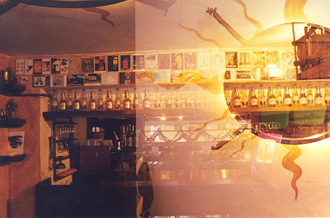 |
 |
 |
 Travel & Outdoors | August 2007 Travel & Outdoors | August 2007  
Gay Aesthetic Enhances Great Haciendas of Mexican Retreat City
 Julia Steinecke - Toronto Star Julia Steinecke - Toronto Star
go to original


| JUST THE FACTS

CD4 WORKS on HIV prevention and publishes a handy QUEERnavaca guide to bars, meeting places and resources, available at Barecito (geocities.com/barecito). grupocd4.org

LESBIAN and gay homestays, see morelosweb.com/arcoiris

THE NEW gay bar, El Cuartel, is at Alvaro Obregón #1104, tel. 317 8249, 157 6385

FOR LUXURY buses from Mexico City Airport direct to Cuernavaca, see pullman.com.mx/english |
Cuernavaca, Mexico – January nights are cool in this City of Eternal Spring but the ambience is warm at Barecito Café.

Straight and gay couples drift in for a visit with Alma, the lesbian owner. Folk and indy music fills the air: CDs are for sale along with local poetry. The walls display artwork celebrating the female body. The friend who brought me gazes at a photo of three nude women lounging on stone steps, and announces: "They're my girlfriends, but they don't know."

We step into downtown Cuernavaca, which is surprisingly gritty and traffic-laden for a Mexican retreat destination. Still, it's quieter than Mexico City from which most of those seeking peace and greenery come.

Most of the beauty of Cuernavaca lies behind the gates of sumptuous private estates, many of which are now turning into hotels.

La Villa Hidalgo is a gay resort in the north end of the city (lavillahidalgo.com). Lush with greenery and teeming with staff, the Villa aims to connect tourists with local members of a private gay and lesbian club who come for afternoon visits around the pool. By day, non-stop, soft, diva and easy-listening music sweetens the air; by night, techno tunes make ripples in the swimming pool until the crickets take over.

Owner Rafael Hidalgo, is a Cuban-born American (with some Italian, Spanish, and French thrown in), whisked away just before Castro's revolution, at the age of three. Later, he left the U.S. in search of the perfect climate ("I was tired of breathing artificial air, heated and air-conditioned") and he found it here.

Though most guests might prefer to come and go in taxis, I'm pleased to discover that a bus passes right by the front door and whizzes me downtown where I find another opulent house, open to the public.

The Robert Brady Museum (bradymuseum.org) is a tribute to an American artist and collector who filled his home with eclectic world art, fabulous guests and scandalous rumours.

More than 1,300 pieces are on view, with origins in Haiti, Cameroon, Bali and other places. There's work by famous Mexican artists like Frida Kahlo, as well as folk art, such as The Last Supper, a clay sculpture by a woman from Ocumichu, which shows the naked disciples eating watermelon and tortillas.

A guide pulls open the drawers in Brady's bedroom to reveal a collection of ostentatious caftans including a South Asian wedding robe. The artist was known to sashay around the city in these, along with the flamboyant jewellery and belts hanging nearby. The guide points out the most worn spot in the carpet, and when I stand there I can see myself in four mirrors placed strategically around the room.

The aesthetic is different at the home of Carlos and Luis, (El Hotelito B and B, Glorieta Parque Melchor Ocampo #13, tel. 011 52 777 312 3058 or 316 4531) a townhouse across from Melchor Ocampo Park.

The first thing I notice is the painting they call Frida Carlos, a takeoff on one of Kahlo's famous self-portraits, except in this one, the monkeys surround the face of my host.

Carlos Villaseñor Martínez is a well-known chef whose recipes are featured on a TV show called Tacos y Caviar. Luis Bracho González comes from a long line of actors and directors whose glamorous photos fill the walls. His aunt, actor Andrea Palma, was one of the first Mexican women to wear pants and smoke cigarettes in public.

Carlos and Luis share their perspectives on Cuernavaca's gay and lesbian scene. Most locals meet in each other's homes, leaving the bar scene for the youth and Chilangos, the weekenders from Mexico City.

Others tell me that young people are more out than ever, but less politically engaged. For three years, activists have been working on a same-sex partnership law for Cuernavaca, similar to the law that took effect recently in Mexico City.

Like the Chilangos from the capital, I head for the biggest house yet, a gay bar called La Casa del Dictador (Jacarandas 4 at Emiliano Zapata, tel. 317 2377 and 317 3186). Chandeliers and candles provide muted light in this labyrinthine mansion full of dark paintings and heavy draperies. Gay men dominate but there are lots of lesbians and I'm surprised to see a straight couple making out in the corner.

They're probably having a secret affair, my friend explains: Forbidden lovers of all kinds feel safe here.

Julia Steinecke is a Toronto-based freelance writer. Reach her at JuliaSt.net | 
 | |
 |



